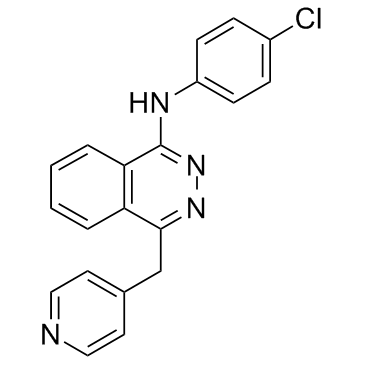
Vatalanib free base
CAS No. 212141-54-3
Vatalanib free base( PTK-787 | PTK787 | PTK/ZK | CGP-79787 | ZK-222584 | ZK222584 )
Catalog No. M13375 CAS No. 212141-54-3
A potent, orally available class III receptor tyrosine kinases inhibitor with IC50 of <1 uM for VEGFR, Flt-1, KDR and PDGFRβ.
Purity : >98% (HPLC)
 COA
COA
 Datasheet
Datasheet
 HNMR
HNMR
 HPLC
HPLC
 MSDS
MSDS
 Handing Instructions
Handing Instructions
| Size | Price / USD | Stock | Quantity |
| 2MG | 50 | Get Quote |


|
| 5MG | 71 | Get Quote |


|
| 10MG | 106 | Get Quote |


|
| 25MG | 203 | Get Quote |


|
| 50MG | 290 | Get Quote |


|
| 100MG | 434 | Get Quote |


|
| 500MG | 972 | Get Quote |


|
| 1G | Get Quote | Get Quote |


|
Biological Information
-
Product NameVatalanib free base
-
NoteResearch use only, not for human use.
-
Brief DescriptionA potent, orally available class III receptor tyrosine kinases inhibitor with IC50 of <1 uM for VEGFR, Flt-1, KDR and PDGFRβ.
-
DescriptionA potent, orally available class III receptor tyrosine kinases inhibitor with IC50 of <1 uM for VEGFR, Flt-1, KDR and PDGFRβ; shows no activity against EGFR, FGFR-1, c-Met, and Tie-2, or c-Src, c-Abl, and PKC-α; blocks the VEGF-induced receptor autophosphorylation in CHO cells ectopically expressing the KDR receptor with IC50 of 34 nM; inhibits EGF and PDGF-induced angiogenesis in a growth factor implant model (25-100 mg/kg).Ovarian Cancer Phase 1 Discontinued.
-
In VitroVatalanib also inhibits Flk, c-Kit and PDGFRβ with IC50 of 270 nM, 730 nM and 580 nM, respectively. Vatalanib shows the anti-proliferation effect by inhibiting thymidine incorporation induced by VEGF in HUVECs with and IC50 of 7.1 nM, and dose-dependently suppresses VEGF-induced survival and migration of endothelial cells in the same dose range without cytotoxic or antiproliferative effect on cells that do not express VEGF receptors. A recent study shows that Vatalanib significantly inhibits the growth of hepatocellular carcinoma cells and enhances the IFN/5-FU induced apoptosis by increasing proteins levels of Bax and reduced Bcl-xL and Bcl-2.
-
In VivoVatalanib induces dose-dependent inhibition of the angiogenic response to VEGF and PDGF in both a growth factor implant model and a tumor cell-driven angiogenesis model after once-daily oral dosing (25-100 mg/kg). In the same dose range, Vatalanib also inhibits the growth and metastasesof several human carcinomas in nude mice without significant effect on circulating blood cells or bone marrow leukocytes.
-
SynonymsPTK-787 | PTK787 | PTK/ZK | CGP-79787 | ZK-222584 | ZK222584
-
PathwayAngiogenesis
-
TargetVEGFR
-
RecptorVEGFR
-
Research AreaCancer
-
IndicationOvarian Cancer
Chemical Information
-
CAS Number212141-54-3
-
Formula Weight346.8129
-
Molecular FormulaC20H15ClN4
-
Purity>98% (HPLC)
-
Solubility10 mM in DMSO
-
SMILESClC1=CC=C(NC2=NN=C(CC3=CC=NC=C3)C4=C2C=CC=C4)C=C1
-
Chemical Name1-Phthalazinamine, N-(4-chlorophenyl)-4-(4-pyridinylmethyl)-
Shipping & Storage Information
-
Storage(-20℃)
-
ShippingWith Ice Pack
-
Stability≥ 2 years
Reference
1. Bold G, et al. J Med Chem. 2000 Jun 15;43(12):2310-23.
2. Wood JM, et al. Cancer Res. 2000 Apr 15;60(8):2178-89.
3. Drevs J, et al. Cancer Res. 2000 Sep 1;60(17):4819-24.
4. Hess C, et al. Br J Cancer. 2001 Dec 14;85(12):2010-6.
molnova catalog



related products
-
Brivanib
A dual inhibitor of VEGFR2 and FGFR1 with IC50 of 25 nM and 148 nM respectively.
-
Pamufetinib mesylate
Pamufetinib mesylate (TAS-115 mesylate) is a potent vascular endothelial growth factor receptor (VEGFR) antagonist and hepatocyte growth factor receptor (c-Met) inhibitor used in the study of cancer and respiratory diseases.
-
(Z)-FeCP-oxindole
(Z)-FeCP-oxindole is a selective inhibitor of VEGFR2 with an IC50 of 200 nM for humans and demonstrates anticancer activity.



 Cart
Cart
 sales@molnova.com
sales@molnova.com


